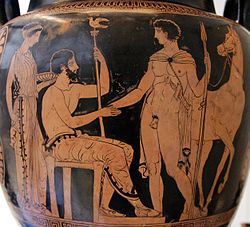



Heroic nudity or ideal nudity is a concept in classical scholarship to describe the un-realist use of nudity in classical sculpture to show figures who may be heroes, deities, or semi-divine beings. This convention began in Archaic and Classical Greece and continued in Hellenistic and Roman sculpture. The existence or place of the convention is the subject of scholarly argument.
Contents
In ancient Greek art, warriors on reliefs and painted vases were often shown as nude in combat, which was not in fact the Greek custom, and in other contexts. Idealized young men (but not women) were carved in kouros figures, and cult images in the temples of some male deities were nude. Later, portrait statues of the rich, including Roman imperial families, were given idealized nude bodies; by now this included women. The bodies were always young and athletic; old bodies are never seen. Pliny the Elder noted the introduction of the Greek style to Rome.
Agnolo Bronzino's painting Portrait of Andrea Doria as Neptune (c. 1530) and Michelangelo's statue David (1501–1504) were Renaissance examples. The convention is occasionally also described in the modern era, such as Antonio Canova's statue of Napoleon as Mars the Peacemaker (1802–1806) or George Bellows' anti-lynching lithograph The Law Is Too Slow (1923).






